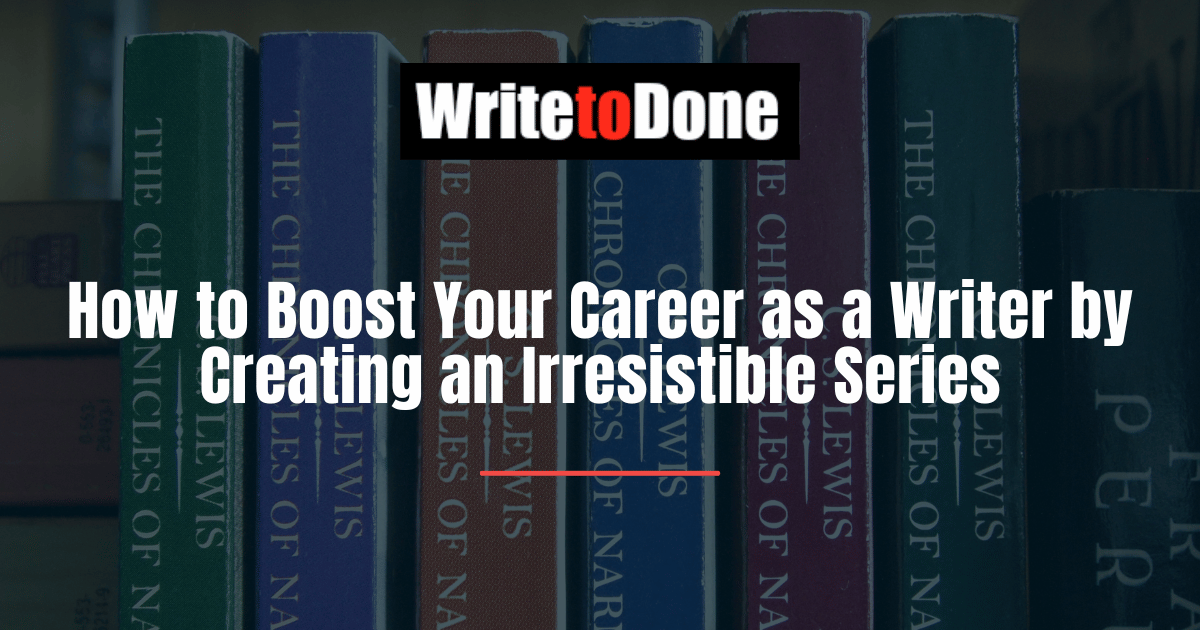Excited about your writing career?
About expanding your story’s potential?
Yet after writing, maybe publishing, even marketing a book, you realize that’s just ONE book. And a career author writes LOTS of books.
Which means tomorrow…
You’ll face a mind-numbing, blinking cursor on a blank white page.
Again.
Fresh Shortcut on Familiar Ground
Do visions haunt you of your single book atop a “free” pile in front of a Goodwill store as you flip burgers to buy printer ink, while trying to come up with something fresh for your next book?
And that’s what you need, right? Another new, fresh story? Then another and another?
Nope.
Writing just one story can build a successful and long-term career for an author.
Huh?
Let me explain:
Satisfying Readers Means a Dead-End for Writers
You know the rules: the story comes full circle; the dragon is slain; peace reigns in the kingdom; your protagonist discovers love; or, at the least, some “End” makes readers sigh and smile. Readers will love you and remember you.
Or not.
Readers may NOT clamber for your next book. Hey, the story is over. Readers close the book, say “Thanks for the read!” and hit the road (well, bookshelves).
If you write one separate story, then another, and another, each must stand on its own, be marketed for its specific content and attract new readers, one at a time.
Sure, you can do that. But there is another way to drive your writing career.
Choose This Route to Creating an Irresistible Series
You still want reader satisfaction at the end of every book. But if you also instill a hunger for “the rest of the story,” you sidestep the narrow pathway of writing individual books and climb the on-ramp to the broad freeway of series writing.
What you want to create for your readers is one long story that meanders through several books. The paths it might take are nearly endless.
A single storyline, a strong storyline, can carry your readers into a world they never want to leave. And propel you into a lifetime career as an author.
Keep the Wheels Turning
In fact, a series can have a life of its own! Here are just two examples:
- Scarlett by Alexandra Ripley, was written as a sequel to Margaret Mitchell’s Gone with the Wind and published 42 years after Mitchell’s death.
Tip: A story can have a life beyond its original author
- After Ellery Adams and Sylvia May published three books in their collaborative A Novel Idea Mystery Series, under the pen name of Lucy Arlington, each wanted to concentrate on their other popular series.
Their publisher signed Susan Furlong, a long-time client of mine, to fill Lucy’s shoes. The series continued with two more from Susan’s pen.
That helped speed Susan’s career; she’s now published her own Georgia Peach Mystery Series, and the first in her new dark suspense series, Splintered Silence, will be out later this year.
Tip: An author attracts devoted readers when they entice with a series.
Road Map Through the Multiple Book Maze
Just writing another book with the same setting or characters isn’t enough. Some preplanning and set-up is essential (well, darned handy!) when writing a set of books.
Don’t freak out—if you’ve already published a book, I’ll explain some great ways to STILL write multiple books from it.
Few writers consider the differences between a series, a serial, sequel/prequels and spin-offs. Each has different parameters that can help—or limit—what you write in later books.
As Mary Jaksch wrote in Fire up a Stalled Novel – Part 1: From Idea to Concept and Premise, “Think about creating a series, right from the start. Creating a series means creating a protagonist who can be the lead character in multiple stories.” She then describes how to create a design layer to plan out the overall concepts behind your series.
Understanding the TYPES of series is essential to that plan.

Never-Ending Stories That Sell
“Series” is often used to refer to any set of related books. But a true series is open-ended, meaning more stories in the same vein without building toward an overall conclusion.
Advantages of Series:
- Write as many books as you want. Sue Grafton started with A is for Alibi heading for 26 alphabetically themed titles. Even more if she wanted to continue with AA is for Allegations Anonymous, etc.!
- Books can be read in any order.
- A series can be written over many years without leaving readers dangling for a conclusion.
Disadvantages of Series:
- Since each book concludes that individual story, what entices readers to buy the next book?
- Even if they enjoy your writing style and protagonist, something must make them feel a need to read the next book.
Solutions:
- A continuing thread of a problem, important to the protagonist, can pull readers along. For instance, the main character solved the immediate mystery or saved the world this time but still hasn’t found love or received recognition.
- Your series might even have different protagonists, like Lauren Willig with 12 books in her New York Times bestselling Pink Carnation Series. Her narrator, Eloise Kelly, focuses on a different historical heroine in each book. Her thread is Regency England/France and a love for English spies.
Closed-Ended Stories That Compel
No matter the number of books, a serial encompasses a single closed-ended storyline. Like a really long story segmented into books instead of chapters.
Advantages of Serial:
- A serial creates excitement for readers who need to read the next book for “the rest of the story.”
- The writer has a destination in sight while writing.
Disadvantages of Serials:
- The books are best read in sequence.
- “To Be Continued” on the final page can make readers impatient for the next book.
- Keeping details consistent in such a long storyline can be a challenge or feel limiting.
Solutions:
- Conclude each book with satisfaction (even if temporary): a goal achieved, a safe haven for characters, or something valuable learned, so the characters—and readers—are rewarded as they await the next book and final outcome.
- Pre-plan your route to the final book, yet be flexible. Keep your serial’s purpose intact as you explore new plot avenues along the way.
Threads That Bind a Serial to a Series
What if you closed out a serial story and then wished you’d gone further with it? Of maybe you have an ongoing, open-ended series but you want it to come to a conclusion?
No problem: you can blend these forms to handle those situations.
How to Close an On-going Series:
Say you wish you could end your series. Use an underlying concept to conclude this storyline. It might be a niggling personal problem that you can (finally!) resolve for your hapless hero. Or the resolution of a constant external problem that has cropped up time and again. Maybe they finally find love, get promoted, or nab their arch villain.
Sir Arthur Conan Doyle published several Sherlock Holmes mysteries between 1887 and 1893, ending the series by using Moriarty, a criminal mastermind in The Final Problem, to kill off poor Holmes. Doyle had Holmes concluding that Moriarty had orchestrated many of the crimes Holmes had investigated over several previous mysteries, even though Moriarty had not actually appeared in them. Doyle revealed (actually created) a thread that worked to pull together previous stories into this concluding book.
Restarting Your Closed Serial
Just because you successfully closed out your serial, doesn’t mean you can’t rethink it later and maybe add to it.
Remember how Sir Arthur Conan Doyle murdered off Sherlock Holmes in 1893? Eight years later he resurrected Holmes when he wrote The Adventure of the Empty House in which Holmes explains to a stunned Watson that he had faked his death in The Final Problem to fool his enemies. Thus began the second set of mystery stories, which Doyle wrote until 1927.
Another example: the original Star Wars trilogy concluded neatly, to be followed by three prequels, and three sequels. Each trilogy could be argued to function as a close-ended serial—but together they became an even larger (and on-going) series.
Pave New Paths with a Before, After or Spin-offs
Is your first book already published? Maybe it doesn’t suit becoming a series or serial? No problem.
Consider a sequel, prequel, or spin-off.
- A prequel is a
- backstory to your original book. It explains how the problems that opened your original book came to be. It might examine the childhood of your protagonist or your main character’s ancestors.It might examine how the world developed to become your original book’s premise, like The Fever Code, James Dashner’s prequel to his popular Maze Runner series.
- A sequel shows what happened after your storyline ended. Although readers like a “they lived happily ever after” ending, they still wonder … what happened later? A sequel answers that question. LikeGo Set a Watchman: A Novel
Go Set a Watchman, Harper Lee’s sequel to her To Kill a Mockingbird.
- A spin-off explores the same theme but from a different perspective. You might re-examine the same story from the view of a different character. Wicked: Life and Times of the Wicked Witch of the West (Wicked Years Book 1)
by Gregory McGuire explores the world of Oz through the eyes of Dorothy’s nemesis, the Wicked Witch. Not only was this a spin-off on the Wizard of Oz, but it became the first in a four-book series, The Wicked Years. A spin-off can reflect a connected subject, something which was not an integral part of the original plot. Consider Fantastic Beasts and Where to Find Them
, J. K. Rowling’s companion book to her Harry Potter series, a textbook for her future Hogwarts students.
How to Expand What You’ve Written Into an Irresistible Series
Love your story? Expand its storyline into some form of series by applying these marketing skills Aaron Orendorff explained in the WriteToDone article Two Complete Content Marketing Examples for Fiction and Nonfiction Authors.
- Your Story’s Goal – Know the purpose behind your story and your writing goals.
- Audience Preferences – Review the expectations and tone your readers prefer.
- Bribe – Create a thread of continuity, so interesting (like your protagonist or setting) those specific readers will want to see it again and again
- Content or Outline – Develop enough framework to keep your writing on track
- Timeframe – Grasp the overall timeframe your multiple books will cover
Choose a type of series that fits your goals and your audience’s preferences. Consider your story’s scope and timeframe. Then explore your multitude of options as you expand your original story.
Tip: Every story is a portion of a bigger picture.

From a Red Light to a Green Light
You crafted characters and a universe you love in one story, so why stop there?
Imagine going to bed with the glow of knowing your fictional universe is still alive, waiting for you.
Imagine waking up tomorrow morning facing not to a blank page, but a wealth of files filled with leftover scenes, character development charts, and the research you already have from your last book.
You can do it.
You can multiply your single story idea into a series concept overnight. And, in the process, increase your chances of satisfying both your reader and yourself with a long-term writing career.
Thoughts? Questions? Please share in the comments.


















